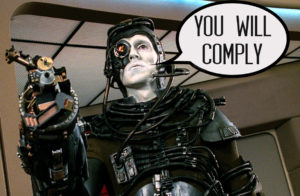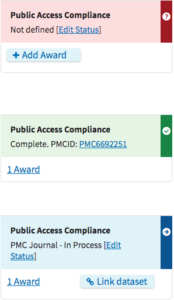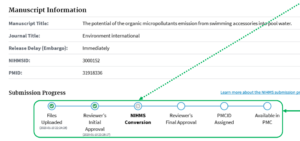Get Your PMCIDs PDQ

Your paper will be assimilated into the PubMed Central database.
Biosketches, progress reports, and other materials that go to NIH need these digits. Here’s what you need to do.
Does My Paper Need a PMCID?
Your paper falls under the public access policy and requires a PMCID if all of the following are true:
- The work reported in the paper was supported by federal funds, including NIH, DOD, CDC, VA, and AHRQ. (This includes if you did the work while on a fellowship, training, or career development grant. These grants fund you, not specific projects, so any research you do should cite your grant.)
- The manuscript was peer reviewed. Case studies, reviews, editorials, and similar items do not require PMCIDs.
- It was accepted for publication on or after April 7, 2008.
- It was published in English.
NIH takes this so seriously that your annual progress report will be rejected if you try to include papers that should have a PMCID but don’t. You also can’t include non-compliant papers on biosketches for grant applications.

Possible statuses for a publication in My Bibliography.
How Do I Associate Funding with My Manuscript?
- Visit NCBI’s My Bibliography. If not already listed, add the citation to your bibliography on the site. You can do this by searching for the PMID or other citation information, uploading a file, or adding the citation manually.
- Once the citation is in your bibliography, you should see a green, blue, or red box to the side of it. (We’ll get to the colors later.) To add grant support, click either “Add Award” or “[Number] Awards.”
- A popup will appear allowing you to choose which of your linked awards belong with this manuscript.
How Do I Get a PMCID?
Once your bibliography is complete, you may notice that some citations have a red box next to them. This means you need to either get a PMCID for the paper or tell NCBI that it doesn’t need one.
If the citation is a review, case study, or other non-peer reviewed work, click “Edit Status” and answer that NIH did not support the work in whole or in part.
For papers in need of a PMCID, there are four potential methods to get one.
- Method A: Journal deposits the article in PubMed Central without author involvement. Hooray! You’re off the hook. List of journals that use Method A.
- Method B: Author asks publisher to deposit the specific article in PubMed Central. This typically means you have paid an open access fee. List of journals and publishers that use Method B.
- Method C: Author deposits final peer-reviewed manuscript in PubMed Central via the NIHMS. The work is all on you. Any journal or publisher not listed in the other methods uses Method C.
- Method D: Author completes submission of final peer-reviewed manuscript the publisher deposits in the NIHMS. List of publishers that use Method D.
If you need to submit the manuscript, you, a co-author, or anyone else on your behalf, such as a research or admin assistant, can do this. Whoever submits will need the final peer-reviewed manuscript (you may need to ask the journal for this), the figure/image files (if separate), which grants funded the work, and the embargo period (default is 12 months). Designate yourself as the reviewer unless your co-authors or PI specify otherwise.
NIH’s excellent guides (with screen caps) to submitting and approving a manuscript in NIHMS
Cite Your Shiny New PMCIDs
When citing your papers, always include the PMCID. If you’ve taken the appropriate actions for your paper based on the methods above but still don’t have a PMCID, do this instead:
- Add “PMC Journal – In Process” to the end of the citation. This is correct if your journal or publisher uses Method A, B, or D and has not yet finished the process.
- Cite the NIHMSID instead of the PMCID. Find this in NIHMS by visiting your home page and selecting the appropriate category from the sidebar, then viewing the specific paper’s Manuscript Information page. This should only be done for three months after publication; after that, you need to have a PMCID.







0 Comments